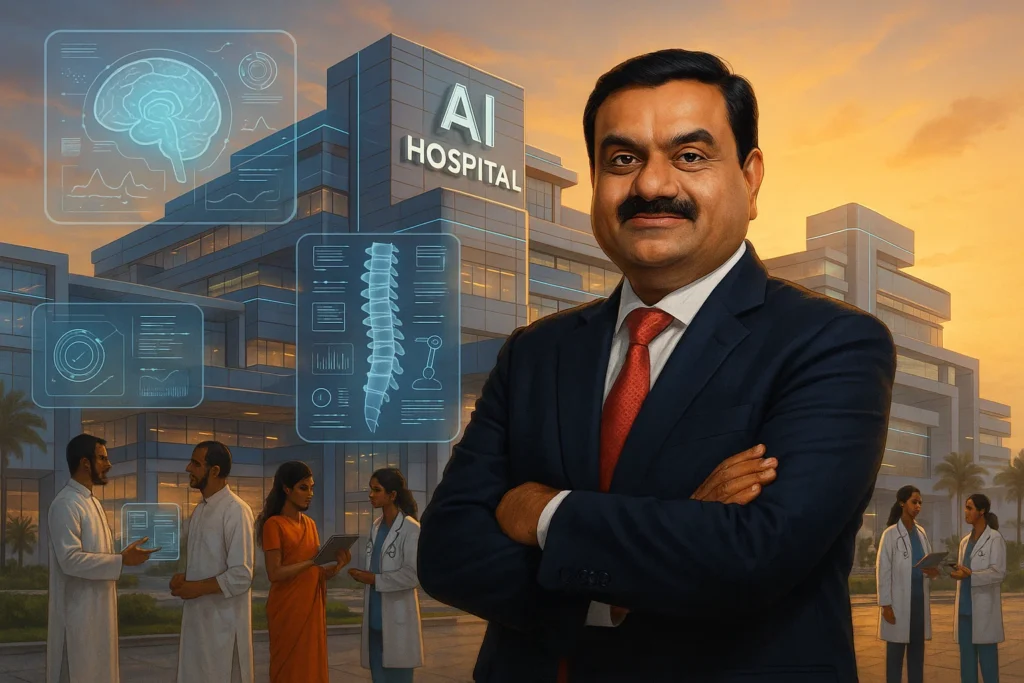Introduction: A Healthcare Vision Rooted in Urgency
The Adani healthcare investment impact could reshape not only India’s medical ecosystem but also the Indian stock market. Gautam Adani has announced a ₹60,000 crore plan to create a tech-driven, affordable healthcare network. This isn’t a small step—it’s a bold move with far-reaching consequences for investors.
Adani’s healthcare vision goes beyond building hospitals. It focuses on AI-first infrastructure, scalable campuses, and integrated care systems. This disruptive model could trigger re-ratings across multiple sectors—AI, diagnostics, health-tech, medical education, insurance, and even real estate.
For investors, the Adani healthcare investment impact presents both opportunity and urgency. With healthcare demand rising and infrastructure lagging, this new push may change how India—and Dalal Street—allocates capital across sectors.
Adani Healthcare Investment Impact: What ₹60,000 Cr Means
Gautam Adani’s ₹60,000 crore commitment isn’t just a CSR gesture—it’s a long-term, strategic bet on India’s most underserved sector. At the heart of the Adani healthcare investment impact is the plan to build AI-first, affordable, and scalable healthcare ecosystems called Adani Healthcare Temples.
These are not traditional hospitals. Instead, they will be integrated 1,000-bed medical campuses focused on:
- Clinical excellence through partnerships with global leaders like the Mayo Clinic
- Rapid scalability in response to pandemics or emergencies
- AI-powered diagnostics and robotics training for future doctors
- Modular infrastructure to expand capacity based on need
- Human-centric insurance models prioritizing patient care over paperwork
These facilities will first launch in Ahmedabad and Mumbai, with potential rollouts in other metro and tier-2 cities over time.
Adani’s bold push positions him not just as a healthcare provider—but as a disruptive system architect for a country whose public health infrastructure has long struggled with access and equity.
For investors, this raises a pressing question: Which listed players might ride this healthcare revolution alongside Adani?
Why Adani’s Healthcare Push Could Shake Up the Stock Market
The Adani healthcare investment impact isn’t limited to hospitals—it could ripple across the entire healthcare and infrastructure value chain, disrupting old dynamics and unlocking new opportunities.
Here’s how the stock market may respond:
1. Adani Group Stocks: Strategic Re-Rating Potential
While the healthcare venture is housed under the philanthropic commitment, parts of the execution—such as infrastructure, logistics, and digital back-end—could involve listed Adani companies.
- Adani Enterprises might play a role in building modular healthcare infrastructure or tech platforms.
- Adani Ports & SEZ could gain from medical logistics as the ecosystem expands.
- Adani Energy and Adani Total Gas may benefit from powering the campuses.
Investor takeaway: Look for cross-functional synergies within the group. The market often rewards conglomerates that successfully pivot into high-impact sectors.
2. Hospital Stocks: Friend or Foe?
Adani’s entry could be either disruptive or catalytic for established players.
- Apollo Hospitals, Narayana Hrudayalaya, and Fortis Healthcare may see intensified competition in metro zones.
- But they could also benefit from increased investor focus on India’s healthcare infrastructure—especially if Adani’s entry raises the overall quality bar and patient trust.
Investor takeaway: Watch for Q2/Q3 commentary from private hospital chains. If Adani’s ecosystem targets affordability at scale, mid-tier hospital stocks could feel margin pressure.
3. Diagnostics & MedTech: Hidden Winners
Adani’s emphasis on AI-powered diagnostics and robotic care puts a spotlight on companies that can partner or supply this vision.
- L&T Technology Services and Tata Elxsi offer medical device design and AI-healthcare solutions.
- Skanray Technologies, Poly Medicure, and Opto Circuits might gain if they secure contracts for diagnostic or therapeutic devices.
Investor takeaway: Look for companies with exposure to imaging, robotics, and telemedicine technologies.
4. Insurance & HealthTech: A Reshape in Progress
Adani’s call for “human-centric insurance models” suggests a nudge toward more inclusive, digitized, and patient-first coverage.
- Policybazaar (PB Fintech) and Star Health Insurance could benefit if tech-integrated insurance products become a core part of the ecosystem.
- Health benefit platforms like MediBuddy, if listed in the future, may ride the ecosystem wave.
Investor takeaway: Expect heightened focus on digital health insurance and tech-enabled health financing startups.
Macro View: The National Impact of Adani’s Healthcare Vision
Gautam Adani’s ₹60,000 crore healthcare commitment isn’t just a business move—it’s a macro-scale disruption. At a time when India grapples with critical healthcare shortages, the sheer size of this investment could realign the entire system.
1. Closing the Doctor-Patient Gap
India has just 20.6 healthcare workers per 10,000 people, well below the WHO-recommended 44.5. Most doctors remain concentrated in urban centers, leaving rural India underserved.
🏥 Adani’s large-scale infrastructure—if spread beyond metros—could rebalance this rural-urban divide.
2. Boosting Public-Private Collaboration
With India’s healthcare budget still under 2% of GDP, public hospitals are overburdened. This opens the door for private healthcare leaders to complement government efforts, especially in Tier-2 and Tier-3 cities.
If Adani aligns with government schemes like Ayushman Bharat, it could shape future public-private partnerships (PPPs).
3. Catalyst for Health Policy Reform
Big moves attract big attention. A player of Adani’s scale could trigger:
- Faster regulatory clearances
- Better incentives for private hospitals in underdeveloped areas
- Push for AI adoption in diagnostics, training, and records
Policy shifts often follow capital. With ₹60,000 crore in play, the government may respond with reforms to support ecosystem expansion.
Challenges, Criticism & the Road Ahead
While Gautam Adani’s bold vision for a tech-driven, scalable healthcare ecosystem sounds transformational, the road ahead is far from smooth. Investors should weigh both the potential and pitfalls before positioning portfolios.
1. Execution Risk: Big Vision, Bigger Complexity
Building large-scale, AI-first healthcare campuses is not just about money—it’s about navigating complex healthcare regulations, state-wise compliance, talent shortages, and tech integration.
- The group has limited experience in healthcare delivery.
- Scaling across Tier-2/3 cities—where needs are highest—requires localised models and patient trust.
Over-promising and under-delivering could erode trust. Watch for actual project timelines and early-stage partnerships.
2. Profit vs. Purpose Dilemma
Even if much of the ₹60,000 crore commitment is philanthropic, a blurred line between charity and for-profit delivery could draw scrutiny.
- Adani’s past ESG controversies mean critics will watch how “affordable” the model really is.
- Questions around pricing, vendor selection, and land acquisition may arise.
Reputation and public sentiment could influence related stock movements, especially if media or regulators raise red flags.
3. Policy & Competition Uncertainty
India’s healthcare policy is shifting fast. Government schemes like Ayushman Bharat and upcoming regulations on private sector pricing could impact how private mega-hospitals operate.
- Adani may need to align with evolving healthcare reforms.
- Incumbents (like Apollo, Max, Fortis) won’t sit idle. Expect pricing wars, regional expansions, and lobbying.
A hyper-competitive market could compress margins—watch for defensive reactions by listed hospital chains.
4. Market Patience Will Be Tested
This isn’t a playbook for quick returns. Adani’s healthcare foray may take 3–5 years before meaningful financial impact shows up on balance sheets.
- Investors chasing immediate earnings accretion from Adani stocks may be disappointed.
- But patient investors could see long-term alpha if the group executes well.
It’s a long-term bet on India’s healthcare transformation—with all its messiness, politics, and complexity.
Conclusion: Will It Redesign Indian Healthcare for Good?
Gautam Adani’s ₹60,000 crore healthcare commitment is more than just a philanthropic gesture. In fact, it signals a long-term structural shift in one of India’s most underserved and underinvested sectors. For stock market investors, this development brings three critical takeaways.
🔹 1. Healthcare May Finally Get Institutional Muscle
Until now, India’s healthcare sector has lacked scale. However, Adani’s entry—backed by tech-first infrastructure and modular design—could bring much-needed consolidation. This is not limited to hospitals. Rather, it includes medical education, AI-driven diagnostics, and high-capacity health campuses.
Therefore, investors should watch listed hospital chains, diagnostics labs, and medical equipment firms. As the bar for quality rises, so will industry valuations.
🔹 2. Policy Support Could Intensify
As a result of this scale and ambition, the government may accelerate health sector reforms. We may soon see incentives for private players, regulatory clarity on medical education, and tax benefits for infra-backed care models.
Consequently, companies in insurance, healthcare IT, and digital health could see stronger growth and policy tailwinds.
🔹 3. A Long-Term Play, Not a Quick Trigger
In the short term, this initiative won’t move the needle for Adani’s listed companies. Yet, over the next 3–5 years, it could lead to spin-offs, joint ventures, or IPO-bound healthcare platforms.
Hence, investors should treat this as a multi-year structural opportunity, not a speculative spike. Use market dips to accumulate strong healthcare stocks with scalable models.
Final Word
To conclude, India’s healthcare system does not need tweaks—it needs transformation. Adani’s bold entry indicates that this shift may finally be underway. For stock market participants, this could be the early signal of a decade-long wealth creation opportunity in Indian healthcare.
FAQs on Adani Healthcare Investment
1. What is Adani’s ₹60,000 crore healthcare investment?
Adani Group has pledged ₹60,000 crore to build AI-first, multidisciplinary healthcare campuses across India.
2. Why is Adani investing in healthcare?
The group aims to fix system-level gaps and build scalable, affordable, and future-ready healthcare infrastructure.
3. What are Adani Healthcare Temples?
These are 1,000-bed world-class medical campuses planned for cities like Ahmedabad and Mumbai.
4. How will Adani’s investment impact India’s healthcare?
It could improve rural access, boost medical training, and drive healthcare digitisation across the country.
5. Is Adani’s healthcare move good for the stock market?
Yes, it could benefit listed companies in hospitals, diagnostics, insurance, and med-tech in the long run.
6. Will this help rural healthcare in India?
Yes, scalable, modular setups aim to bridge the urban-rural divide in medical services.
7. What sectors may benefit from Adani healthcare investment?
Healthcare infrastructure, diagnostics, health-tech, insurance, and medical education may gain the most.
8. Is this part of Adani Group’s core business?
Not yet—but it aligns with their long-term strategy for social infrastructure and national development.
9. Will listed Adani companies gain from this investment?
Not immediately, but future spin-offs or JV models could unlock value over time.
10. How does this compare to other private healthcare initiatives?
Adani’s approach is tech-first, modular, and designed for both scale and emergency response—setting a new industry benchmark.
Related Articles:
India’s Obesity Crisis Fuels a Billion-Dollar Boom: Top Pharma Stocks to Watch
Best CDMO Stocks in India to Ride the Global Pharma Outsourcing Wave
PC Jeweller Turnaround: Will the ₹500 Cr Fundraise Bring Back Its Old Glory?
More Articles
Foreign Bonds Investment: A Complete Guide to Global Debt Markets
How to Track All Mutual Fund Investments Using PAN – Step-by-Step Guide
The 15-15-15 Rule: Why the ₹1 Crore SIP Dream Needs a Reality Check






